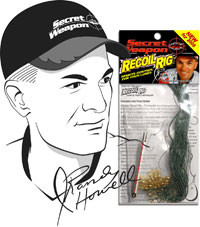|
|
|
Welcome to the IMA Emailer — January 2010 Issue The IMA EMAILER brings you news from IMA pro staff members across the USA and worldwide. Find all your Ima baits at BassTackleDepot.com
Thanksgiving, Christmas and New Years are now firmly in the rearview mirror and the 2010 fishing season is rapidly beginning to occupy most of our thoughts. South Carolina pro Michael Murphy is a little different, however. When it comes to describing his latest pet project, the Ima Flit 100 jerkbait, he’s still got Turkey Day from two months ago on his mind. “Sometimes big fish want a snack and not a meal,” he said. “Think about Thanksgiving. You’ve just eaten a big meal and you’re completely stuffed, but you go by the table and you see some desserts. Which are you going to grab, a cookie or a big piece of pumpkin pie?” His point is that the overstuffed gluttons among us can’t resist, but on those occasions when there’s only a little room left to fill it’s the bite-sized morsel that’s going to get us every time. Big bass are the same way. They want to eat all the time, but sometimes it’s the little temptations that are deadliest. This is the primary reason why the engineers at Ima made the decision to add a 100-sized bait to the wildly successful Flit 120. Together, they’re a dynamite combination for your jerkbaiting needs — like a sharp left jab and a brutal right hook — ready to put fish in your livewell under almost any conditions. While the 120 outperforms its competition and can be used it an exceptionally wide range of circumstances, Murphy said that its little brother adds to its versatility. He wouldn’t want to be without either one in the boat at any time. “Here’s the lowdown,” he explained. “The 120 is a typical, popular three-hook design. It’s made for fishing on the highways the fish use, the migration routes and channel swings.” But on lakes like Guntersville, where the grass flats top out four feet under the surface, at times the Flit 120 is too much. If you need a shallower diving model, or the forage is small, “this bait makes a lot of sense,” Murphy concluded.
So other than when you want a shallower diver, when is the Flit 100 your top choice? Murphy flips the question around on you — When don’t you want it on the deck? — he always has both models of Flit ready in the rod locker. With the smaller bait, the key factors are smaller prey size and less aggressive fish. The size and species of the dominant forage is a constantly changing variable throughout the year — you can be in the right place, but if you’re off by an inch or so in “matching the hatch” you can miss the boat. Too big and you’ll miss out, but the reverse is true, too — baits that are too small sometimes won’t get the attention of even the most ravenous fish. Thus the need for two different Flits, even though they’re similar in other ways. “It’s designed to move the same as the 120, but on a smaller scale,” Murphy said about the Flit 100. “The walk is not as severe. It only has half the twitch and it doesn’t have as much sound because there aren’t as many BBs and they’re in two chambers instead of three. It’s a softer, less intrusive version of the same bait. It’s the same kind of ping, but at times when the fish are skittish, it’s possible to get too much sound.”
While many anglers think of jerkbaits as tools for cold weather leading into the spawn, Murphy says that given the right circumstances, they can be killers 12 months out of the year. After all, the thin minnow profile is undeniably tempting to bass from coast to coast and around the world. “I just feel comfortable throwing it all year long,” he said. For example, while other anglers used “texposed” soft jerkbaits at an FLW Series tournament on Clarks Hill this past fall, Murphy avoided the frustrations caused by missed strikes by substituting the new Flit. “You can fish it in many more ways than other jerkbaits,” he added. “A lot of times with a jerkbait they’ll just slap the tail end of it. With this lure, if they even graze it, they’re hooked.”
The number one gripe of hard and soft jerkbait fishermen everywhere is bass that follow but don’t strike. One moment, you have a water-borne missile that’s making a charge for your lure, the next minute she’s sinking back into the depths. In designing the Flit, Murphy and the entire Ima team took this into consideration. “You can make it do a 180 and persuade that strike to happen,” Murphy said. Around docks on lakes like perennial FLW Tour stop Lake Norman, Murphy said the fish get so accustomed to following other lures like flukes and paddletail swimbaits, that it often takes something different to get them to strike. “They’re educated. After someone fishes the dock you have to leave them alone for an hour and come back. You have to trigger the strike, but if they swipe at it one time, you’ll get them hooked up. For that reason, it’s great for going behind people.” While the 100 doesn’t dive more than about five feet deep, like its big brother it’s deadly over deep, clear water. On lakes like Champlain (on the Vermont/New York border) or Murray (near his South Carolina home), Murphy uses the flit to call up big largemouths and smallmouths out of extremely deep water. Let forage size and the depth at which the fish are suspended be your keys in determining which Flit to throw. “On Murray I’ve caught them over 30 feet of water,” he said. “You’ll have a rockpile at the end of a long point so the bottom comes up to 25 feet with 10 or 12 foot clarity. They’ll suspend between the structure and the surface and you can catch more fish with the Flit than you can by fishing underneath the fish.” It’s also deadly in the coldest part of the year. While others toil away in a deer stand or a duck blind, Murphy can often be found as the lone figure on the lake, mopping up bass as if they’ve never seen a lure. Right now is when you need to be out there, he said. “It’s winter and turnover is done but we haven’t had a big shad die-off. The bait is in the coves where the fish have them corralled. They’re about three-inches long, mainly the young of the year. On lakes like Old Hickory, they’re so thick you can almost walk across the water on the shad. Crankbaits, poppers and spooks don’t match the hatch. Not only does the Flit 100 match the hatch, but you can walk it back and forth six or seven times in a three foot pull.” It’s that type of torture that often pulls in the biggest fish of the year. The strikes are sometimes subtle — just a “tick” or a slow swimming away — but when you rear back the fight is on.
Look for an announcement from Murphy in the not-too-distant future of a signature jerkbait rod. We can’t give away the details yet, but it’s going to be a perfect tool for the Flit, part of a system he’s developed for maximizing the bait’s effectiveness. While we can’t tell you who is going to make it, we’ll give you the lowdown on the specs so you can use the right rod from your current arsenal. “It’s 6’10” with a real limber tip,” he said. “I call it a medium-heavy, but it’s not a typical medium-heavy. It’s similar to a crankbait rod with a softer tip and a lot of backbone. It’s somewhere between a medium and a medium-heavy. The problem is that if you go into the store, no two medium-heavies (from different manufacturers) are the same. You want to make sure it’s on the lighter side, not the heavier side, so you can make extremely long casts.” “I’ve played around with a lot of different lines,” he continued. “I prefer fluorocarbon, 8 lb. test with the Flit 100 and 10 lb. test with the 120. You can also use mono if you don’t want it do dive as deep.” Just remember, this is hawg time, and the bite-sized morsel called the Flit 100 may look like a snack, but you should expect to get some big bites mixed in with the numbers. So don’t pull too hard on that light line. Keep the fish away from the cover, but baby them once they’re in open water. The sharp hooks will hold and you’ll really have something to be thankful for. And with New Years Resolutions in place, even a fish on a diet can occasionally afford to splurge on a snack-sized bait. For more information about the Flit and the entire line of Ima lures, go to BassTackleDepot.com |
Category Archives: Tips and Techniques
IMA Emailer – October 2009
|
||||||
 |
Give this a try, I think you’ll dig it!
Here is a little tool that I developed mainly for my own use last spring and shared with a few close fishing buddies last year. I finally decided it was too handy not to share with all of you. Basically, I created a downloadable and printable PDF Tru-Tungsten Size chart for your weights that you can adhere to the inside lid of your terminal tackle box. If you are like me, your hook box is a disaster and all your Tru-Tungsten weights are all mixed up, this way you can keep track of what weight you are using and when someone asks you, you can tell them. Or when you get busted off, you can go back and make sure you use the same size that was working.

You can see how handy this can be for my hook and weight box!

Here it is in use, you can see, I also created a Flipping Weight Chart as well.
Click Here to Download TT Weight Chart
Click Here to Download Tru-Tungsten Flipping Weight Chart
Couple things to note, make sure your print settings are set to 100% or No Scaling to get the right size, when it prints there are some inch lines that you can measure, if they don’t measure properly, adjust your print setting until they do! Any paper will work, but I think a card stock holds up a little better, I am sure you can find a sheet or two of the heavier cardstock in your office ![]()
Then I just use clear box tape to completely cover it and adhere to the inside lid of my hook box. If you have access to a laminator, even better. Let me know what you think.
And if you are now in need of some weights to go with your new chart, check out the selection at BassTackleDepot.com!
Hope you find this as useful as my buddies and I do!
RichLindgren.com
Rich’s Bassin’ Forum
Bass Fishing Tackle Blog
ima Emailer ~ April 2009
April 2009 Issue – The IMA EMAILER brings you news from IMA pro staff members across the USA and worldwide.
![]()
Anglers everywhere experience down cycles on their favorite waterways. Maybe a drought or other inclement weather conditions cause the fish population to be less than abundant. Or perhaps a shad die-off or a couple of poor spawns have limited the number of fish that are willing and able to bite. Even worse, sometimes your secret honey hole gets a reputation as a top producer and is suddenly flooded with anglers from all over the region, or even all over the country, and the added pressure causes the quality of the fishery to nosedive.
Whatever the reason, you still need to fish and you still want to have bulging livewells at the end of the day. There’s no time for excuses — life is too short to fish with subpar baits. Luckily IMA has specifically created lures aimed at dealing with these difficult conditions, and they work from coast to coast, wherever bass swim.
Our IMA pro-staffers are more than willing to fill you in on the hows and whys of fishing for pressured spring fish.
![]()
California guide Randy Pringle is on the California Delta nearly every day. When he takes a day off, it’s usually to hit one of California’s other storied bass waters, like Clear Lake. In over 20 years of fishing professionally, he has gained a reputation as an unequalled educator and spokesman for the sport. He has also gained an incredible understanding and knowledge of the finicky but often outsized bass that reside within spitting distance of his California home.
But Pringle related that this has been an atypical year on the world famous Delta: “We’re three weeks behind on the weather,” he said. “We haven’t gotten the water flow that we normally get and that has resulted in some lighter than usual tides.”
“Normally, we see a lot of 30 pound limits this time of year,” he continued. “But it’s often taking just 15 or 20 pound limits to do well so far.”
RANDY`S GO TO BAIT THIS SPRING HAS BEEN THE FLIT IN THE TENNESSEE SHAD PATTERN
He rode the Ima Flit jerkbait for a long time over the winter and spring. “It’s been a great Flit year,” he said. “When we have the types of weather changes we’ve had and the fish pull off, it’s second to none. It allows you to keep the bait in the strike zone. You can pause it at depth and the head keels itself level and that triggers a strike.”
He keeps the Flit on the deck well into the spawn, but by April his attention often turns to a small-profiled crankbait bite. He noted that the Delta is known for being a big bait testing ground, but sometimes it takes a smaller package to get even the largest predators to bite.
“We have a large population of both large fish and smaller fish and you’re trying to get as many bites as possible,” he said. “Right now, as the water starts to warm up, the fish are staging so the Ima Shaker comes into play. Especially on a high tide, you can tick the weeks with it. These fish are really protecting their spawning areas, so I usually use bluegill or crawfish patterns.”
Why the Shaker and not another flat-sided lure?
“It really has a unique wobble,” Pringle answered. “It deflects off of hard objects like rock and wood. When you pause it, it floats up rapidly out of the weeds. It has such a wide wobble that you know instantly if you’re getting down into the weeds. Your rod tip will tell you. With a lot of other crankbaits, you can’t really tell what you’ve hit.”
![]()
Even though he lives 3,000 miles away, a full country apart, Capt. Karl Bunch agreed with Pringle that it’s getting to be prime time for the Ima Shaker. The fellow educator and full-time guide recently saw his home water, the Upper Chesapeake Bay, in the national limelight when BASS held a Northern Open there. The pictures of the event showed dozens of anglers congregated in limited areas, flinging similar lures, most of them coming away with exceptionally meager catches. In many cases, anglers who caught 15 or 20 pounds one day, weighed in one or zero keepers the rest of the event. It was that tough to put 15-inch bass in the boat.
Like California, Maryland has suffered some oddball weather patterns this spring.
“It seems like every time the water gets up to 52 or 54 degrees something happens and it knocks it back to the high 40s,” Bunch said. “We shouldn’t be having these big fronts in April. So it was tough up here. It’s like the fish are waiting at the starting gate and we’re teasing them. They want to come up and spawn.”
Like Pringle, he’s put the Ima Shaker in his clients’ hands to put keeper fish in the boat when others are catching only shorts or nothing at all. He still uses the Rock N Vibe to cover large expanses of grass flats, but when he finds heavy timber or channel edges, sometimes the Shaker is all he can get them to bite. In the murky water that has resulted from abundant rain, he likes either chartreuse with a blue back or the Plemmons color.
“It works. That’s all there is to say,” he exclaimed. “It has such a wide wobble that sometimes my clients will ask me if it’s running right. But these fish have so much area to move around in, it’s almost like a secondary search bait.”

THE SHAKER`S WIDE WOBBLING ACTION HAS OPENED UP A LOT OF ANGLER`S EYES THIS SPRING.
He hopes that things will “settle up” in the next few weeks and expects that when that happens, “it should all bust out at once.” Then the Roumba will become his primary search tool, but until then he’s confident that he has something that can distinguish him from the crowds.
![]()
Bill Lowen and Fred Roumbanis come from different ends of the country and from very different home waters, but the one thing they share is their exposure to tough competition. Bill calls the Ohio River home — it’s probably the stingiest of the major tournament fisheries from coast to coast. He’s developed a keen sense for what makes a bait stand out for fish that can name the size, model and serial number of almost every lure in the book. Fred now calls Oklahoma home, but he was raised fishing the monster bass waters of northern California, storied hawg factories like Clear Lake and the Delta. Those bodies of water may be prolific producers of monster limits, but they’re also home to some of the best local competition in the country, so winning is never easy.
Now they’re both on the Elite Series, fishing against the crème de la crème of the nation’s best professional anglers — and they’re still kicking butt, thanks in part to Ima lures.
After three events, Lowen is 16th in the Angler of the Year standings, the exact same position he was in after three tournaments last year. Over the remainder of the season he actually managed to improve his standing. He moved all the way up to 11th. That same climb would be especially welcome this year, when all but the top twelve anglers will call it a season after eight events. The remaining twelve will fish for all the marbles in two no-entry fee tournaments.
Lowen’s success dates back to the end of last season. Combined with the first three events of this year, he’s cashed a check in six straight Elite Series tournaments. Last year, when he had not yet signed on with Ima, he was already using the baits to catch bigger than average fish, but now that he’s on the team he’s depending on them.
BILL LOWEN HOLDS A HEFTY BASS HE GOT WHILE TOSSING THE ROUMBA
He used the Roumba at all three events this year. Most recently, at Wheeler, where he finished 25th, it was part of his arsenal in practice but played less of a role during the tournament. But at Amistad, where he finished 33rd, and at Dardanelle, where he was 17th, it was a critical part of his game-day strategy.
He’s seen every crankbait under the sun, from mass-produced models down to the garage baits that his home state of Ohio is famous for producing. What makes the Roumba so effective? “It comes through cover like no other crankbait,” he said. “Particularly aquatic vegetation, like water willow and lily pads. It still amazes me.”
We’ll share some more of the Ima pros’ Roumba secrets next month, but for now Lowen did want fellow anglers to know that he’s throwing it on a 7′ heavy-action All-Pro APX Series rod and 15-20 lb. test Trilene Big Game monofilament. He doesn’t want to give all of his secrets away quite yet, largely because he expects it to be part of his successful tournament at Guntersville in a few weeks. It should also be deadly at the Mississippi River in Iowa later this year, as should the Ima Shaker.
Like Bill, Fred Roumbanis is within the Classic cut after three events, sitting in 33rd place overall. He started off with a check at Amistad(44th) and recently stumbled a bit at Wheeler (with a not-all-that-miserable 69th), but in between he unlocked the code at a difficult tournament on Lake Dardanelle in AK and cashed an 8th place check. The Ima lures, particularly the Flit rip bait, have been key search tools for him during practice. He also filmed an episode of ESPN 2’s “Day on the Lake” television show where the Flit showed its colors as a true fish-catching machine.

IT`S HARD TO BELIEVE, BUT THE FLIT GETS DOWN TO 8 FEET.
“It has helped me tremendously,” he said. “Especially if they’re on the beds, even if they won’t bite it, they’ll come up and chase it.” Accordingly, he fully expects it to play a role at this week’s sight fishing slugfest at Virginia’s Smith Mountain Lake. While he said on the first morning of the tournament that he had nearly 50 beds marked on his GPS, consensus wisdom is that it’ll take some hefty pre-spawners or fish that aren’t fully locked down to have a top showing in this event.
But once the spawn ends, Fred won’t put the Flit away. “I have it tied on and ready to go year-round,” he said.
While he’s not looking past the next few events, Fred is particularly stoked to hit the Mississippi River near Ft. Madison, Iowa, later this year. It promises to be a backwater brawl, and while flipping and frogging will be key, he also believes that his signature bait, the Roumba, will prove to be a critical element in his success, and his ticket to another Classic appearance. Again, we’ll report more on the Roumba next month, including some tweaks, tricks and new models that you’ll need to add to your arsenal — in the mean time, keep on cranking.
ROUMBANIS WILL BE RUNNING AN IMA WRAPPED BOAT FOR THE `09 SEASON.
Secret Weapon Lures’ Economic Stimulus Plan
|
||
|
Bassmaster Elite Series angler Randy Howell’s weapon of choice is the Recoil Rig. Howell used this rig in the past to upgrade his drop shot presentation, and he’s discovered a number of new ways to employ it.
Here’s a tip you can use: As spring creeps northward, bass are heading to the beds. The Recoil Rig with a creature bait or lizard, shaken hard right over the bed, then letting it drop into it, catches fish quicker than anything else out there. Learn more Recoil Rig information and techniques on Secret Weapon’s Website. |
Keep an eye out for a post that I am working on called: Bass Fishing in a Recession!
RichLindgren.com
Bass Fishing Today
Rich’s Bassin’ Forum
Bass Fishing Tackle Blog
How to Rig a “Stupid Tube” – Best Jig Heads & Baits
I have had many people leave messages both on my blogs and social media. How do you rig the “Stupid Tube”?
The Stupid Tube was made famous when Federation Nation angler Terry McWilliams from Indiana made the Bassmaster Classic through the Federation Nation ranks, largely on the fish he caught on his “Stupid Tube”. It got the name because anglers back home always asked if he was catching fish on “That Stupid Tube” he so often used to beat them with. See article on Terry here.
The only real difference between a Stupid Tube and a normal tube jig is the way you rig it. The stupid tube still used a tube jig head or similar jig head, but you kind of rig in a hybrid between a Texas rig, normal tube rig, and a shaky head! Below are picture diagrams of how to rig your own “Stupid Tube”. The reason the stupid tube rig is so deadly, you get a similar erratic fall and action as an exposed tube jig, but its virtually weedless and still gets great hook ups on fish!
Start out with your favorite 3-4″ Tube, and either a tube jig head, shakey head jig or even a ball head jig. The jig shown here is a Shakey Head and a 3-1/2″ Strike King Coffee Tube. My new jig head of choice is the BassTEK Tungsten Agitator Finesse Head.
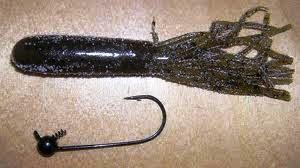
Start by inserting the hook point into the hollow end of the tube
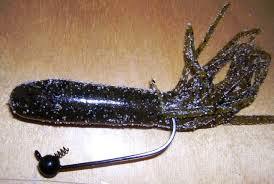
Run is all the way up and poke it out through the tube wall near the head, about whereTexasxas rig hook would come out, about a 1/4″ from the nose of the bait. You will find where you like it for your jig with a little practice.
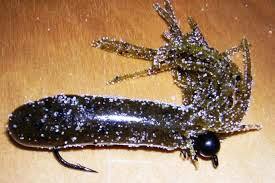
Pull the hook out, so the head fits snug up in the nose of the tube & then poke the eye of your jig head out the other side of the tube, so you can tie your line there
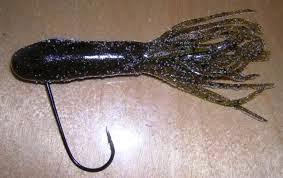
Then bring the hook back into the tube body and out the other side like a Texas rig and then skin hook the tip of the hook back into the tube wall so it covers the point of the hook (Texposed). This keeps the hook from catching on snags & weeds, but only takes a little pressure to stick a fish!
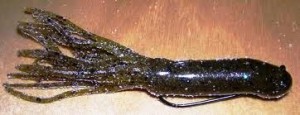
Experiment with different jig heads, weights, hook & tube sizes to fit your needs, just be sure your hook has enough throat to stick the fish and let tube collapse on the hook set. This bait comes through cover and skips great. Another big advantage over Texas rigging your tube is that Texas rigging tends to tear up tubes real bad after just a few fish. You usually can catch a limit or more before you need to replace your tube with this rig. So rig a handful up the night before and you should be set for the day!
June 1, 2015 – Update
Just to refresh this post and keep it up to date, few things to add. I still use this rig all the time for both smallmouth bass and largemouth both. Details on my setup, usually I fish this with 12lb Fluorocarbon, Dobyns DX743C baitcasting rod, and the jig head is usually a 3/16oz BassTEK Agitator Finesse Head.
Also if you prefer videos, check out this How to Rig a Stupid Tube video.
Rich
RichLindgren.com
MNBFN Presnents Free Bass Fishing Seminars
January 17th will be the next installment of Free Bass Fishing Seminars (open to the public) brought to you by the MN BASS Federation Nation
January 17, 2009 at the Medina Entertainment Center
9:30am – 11:00am Ross Evans – Side Imaging Systems – GPS Screens, Mapping Screens, Interlinking Units, extensive understanding of SI and how to link together with the GPS & Mapping
Here is the details of the SI seminar:
1. Transducers – Difference cone angles and why.
2. Mapping – Talk about the Chips and how to modify your screen to make better use of your chips.
3. Mounting and Interlinking Units to improve your over all performance of the units.
4. SI – Will explain in better detail how it works and why it works. I will also use the above three discussion points to help the unit work better.
I will use two overriding themes for the day:
1. Concentrate on what your Unit CAN DO and not what it can’t do!
2. Side Imaging is a “System” and not a single unit!
March 7, 2009 at the Medina Entertainment Center
9:30am Sport Smith – Tackle Craft & Modification
10:15am Rick Billings – 2008 Divisional & National Tournaments Recap
April 18, 2009 at the Medina Entertainment Center
9:30am TBD
10:15am TBD
Look forward to seeing many of you there!!!! – http://www.mnbfn.org/membership/meetings.html
ima Emailer ~ November 2008
| Welcome! to the ima Emailer ~ November 2008 Issue |

The IMA EMAILER brings you news from ima pros Fred Roumbanis, Michael Murphy, Bill Smith and ima pro staffers across the USA and worldwide.
| ima Pro Fred Roumbanis Makes Amistad Easy |
What does ima pro-staffer Fred Roumbanis do when he gets time off from his busy tournament schedule? You guessed it, Fred goes fishing!
In this issue, Fred tells us all about one of the country’s hottest new trophy bass destinations – Lake Amistad which straddles the border between Texas and Mexico. Amistad has become one of the hottest big bass destinations for US anglers in recent years.
Recently, Fred and Optimum Baits CEO Matt Paino headed down there to enjoy a Texas-style trophy bass fun fishing trip. They stayed at Byron Velvick’s Amistad Lake Resort.
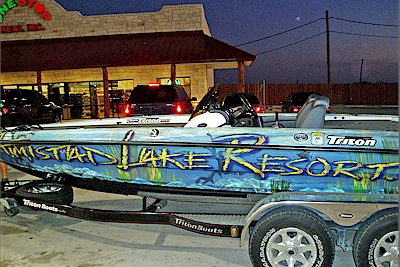
Matt Paino says, “We would like to include our appreciation and gratitude to Byron Velvick. We stayed at his Amistad Lake Resort. The accommodations were great and Byron made sure that we, like all his guests, had an enjoyable time at his resort. One day, Fred ran into engine troubles and Byron let us use his boat and really bailed us out.”
| Destination Amistad |
Since the Bassmaster Elite Tour first started stopping there only a couple of years ago, Amistad instantly became a hot destination for many anglers from across the country, and for those who have not been there yet or who are thinking to go there soon, I’d like to make this not only an ima story but also a destination piece, says Fred Roumbanis.
I’ll talk primarily about ima baits but also include the other baits that I would typically use on Amistad, meaning swimbaits.
So, I will give some information about those lures, but also the story’s meant to help you do well if you go to Amistad – and this kind of story’s called a ‘destination piece’. So here goes!
| Fred’s History on Amistad |
My history with Amistad is, the first time I went there in November 2005 was right after a Bassmaster championship, I swung by on my drive home and fished Amistad for about four hours and caught about fifty bass. Nothing over three pounds, but just tons of fish, and I was blown away with how awesome the lake was.
So I was really excited to think I’d be coming back the next season in the spring when the big fish would be up and the Bassmaster Tour would officially stop there for the first time. What I’d heard was Amistad is an awesome springtime lake, big fish move up then in the clear water so you can see them, almost like in an aquarium. I was psyched!
I had that whole winter to plan for how I would approach Amistad. I had been thinking about trying my California-style swimbait tactics on Amistad, and I thought maybe I would have that whole technique to myself there, which I pretty much did. Swimbaits were well-known of course in California (where I grew up), but still at that time, swimbaits were not widely used on the pro tours.
Well, I finished second to Ish Monroe at that first Bassmaster Elite on Amistad in 2006, but in so doing, I actually brought swimbait fishing into the Bassmaster Elite series for the very first time. So that was a big deal for Amistad because not only did Bassmaster TV coverage of that event help Amistad become a hot new destination for big bass almost overnight, but it also become a destination for people to use big baits.
That first tournament on Amistad in March 2006 was pretty amazing. I thought I did everything in the off-season to be ready for those big fish, and Bassmaster had definitely scheduled the best time for us to be in there. I was confident going in that I would break 100 pounds at Amistad, and I did with 101.13 for 4 days.
I was catching 20 fish a day on a swimbait, all over 4 pounds, and culling 4’s to get 25 pound bags. The tournament came down to whether I’d get the one or two bites to make me a really big bag of fish. I caught so many quality fish the final day that my camera guy ran out of tape with about a 1/2 hour to go before weigh-in, and on my very last cast I hooked a nine-pounder. I actually touched and almost grabbed it before it bolted under the boat and got stuck in a tree and ended up losing the tournament for me. It’s funny but ‘losing’ the tournament meant I came in second place.
Despite that, I definitely was prepared for that kind of fishing on Amistad. I grew up fishing the California Delta and Clear Lake. Those are two big bass factories where I had really cut my teeth in tournament fishing. So big fish have always been something that I have been prepared for, and I really prepared myself for what Amistad had potential for. I just got that one bad break and dropped that nine-pounder that cost me the win. I had to live with that throughout the season. I had some nightmares you know, awful nightmares. I could have easily kept that nine-pounder engaged and brought it up, but I decided to feed it some line off the spool by hand. I had thought I was in open water, and I did not realize my boat was sitting right on top of a tree. As you may be able to tell, that one mistake still haunts me.
| Early Morning Roumba |
One of my main things whenever I go to Amistad, I go there with the intention of fishing for big fish. So I want to throw big baits. Like with the ima baits, let’s take my Roumba topwater for instance. I didn’t just want to throw the solo Roumba. I wanted to big up the presence of that bait by adding a tail section of a swimbait to the back of it, attached by a HitchHiker screw wire coil clipped on the back split ring. This gets clipped to the split ring above the rear treble hook.
What that does with the swimbait tail attached, it displaces more water on the surface, it kicks and gives the Roumba a bigger profile and presence. So we rigged the Roumbas like that on Amistad.
In the mornings, they really ate the Roumba well. I mean we had a solid Roumba topwater bite to start each day. Most mornings, you can have until about 9 o’clock for this. So basically, you have about 2 to 2-1/2 hours of good topwater fishing in the mornings on Amistad.
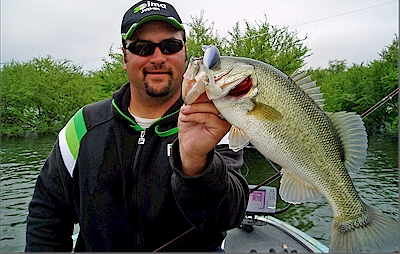
Look closely to see the swimbait tail that’s been attached by a wire clip to the end ring of this Roumba. The clip and swimbait tail swing independently above the tail treble hook.
| Midmorning Flit |
Some time around 9 o’clock each day, the fish tended to stop roaming and would begin to tuck up into the cover, especially if the sun poked out. So then we went with the ima Flit. It’s a three treble hook jerkbait, almost five inches long. So it’s a good-sized jerkbait, what they call a ‘120’, and that’s just a little bigger than most other jerkbaits on the market.
Once they headed into the cover, which was bushes, shrubs and several kinds of scrub trees, you could still pull them out of there with the Flit. You could jerk it around the bushes, and make them come out and attack it. We were not really pinpointing a certain type of bush or tree. It didn’t matter. However, I did seem to notice some of the bigger fish came off salt cedar trees. It seemed there were more bugs or insects in the salt cedars when they flooded, and probably because of that, more bluegills and baitfish were around them. Even more spider webs were obvious in the salt cedars, and those trees with more bugs had more baitfish and bigger bass in them. Life attracts life!
When the fish tucked up into the cover after the morning topwater activity, the reason why we started to throw the Flit at them in the cover, is because of the way you can jerk the Flit around the bushes, it commands attention. It really shimmies when you work it. Then you let it suspend there for a second, and that truly antagonizes them. So the Flit moves real quick and erratically, and then it just sits there. And they come out and grab it. You can stop it right where you think is best, right in front of the bush where you think a bass is holed up. It’s not like something that’s swimming by, that’s only passing through. It stops and stays right in front of their bush. So it’s kind of like sitting there in their space, and they’re going to attack it for that reason. It triggers that reaction bite. These fish, they may not come out for something that’s moving past. If something just keeps going and passes by the bush, they’re not going to bother it. But as soon as the Flit stops and hangs around, that’s what makes them react on it.
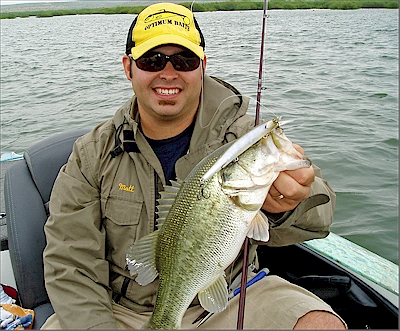
Matt Paino savors the moment with a nice midmorning Flit fish. Matt says, “My one most important comment may be, when preparing to come to Lake Amistad, plan on upscaling all your baits. If you are used to throwing a 4″ jerkbait (100mm or so), go bigger and tie on the 5″ (120mm) ima Flit, for example. The lake has a good mixture of bait, ranging in all sizes. There is big and small bait for bass to choose from. However, you’ll have better chances to catch the bigger fish at Amistad if you throw the little bit larger baits.”
| Early Afternoon Swimbait Bite |
In the afternoon, you may want to get out the swimbait. The swimbait we threw during this trip was a new one that Optimum came out with – the Baby Line Thru. It’s a five-inch swimbait and its got a really wide head to it. That big head gives it a little bigger presence in the water. It just makes it look like a big, easy baitfish to a bass. So the BLT was our swimbait of choice. You can check out the new Baby Line Thru at www.optimumbaits.com.
Of course, you could catch swimbait fish early too, but after lunch was really when we’d use them. The bass at this time of day were deep in the thick grass. You’d want to cast the swimbait out and let it sink for a little bit, and get a slow roll down deeper usually on the inside grass lines. Where the grass is, an ideal depth for this is around 15-16 feet, so you want to slow roll that swimbait down through that, near the grass, near the tree tops, swimming in and out of the cover.
The cool thing is, as the water level rose daily on us during this trip, the grass was almost like kelp. What I mean is, at low tide in the California Pacific ocean, kelp looks like a mat all balled up and lays over on the surface. Well, as the water rose on Amistad, the grass stood straight up. So you can actually work your swimbait through it a lot easier. It wasn’t really matted up or too dense, not too tight together. There was a lot of room in the grass for the swimbait to move through it pretty freely.
So that’s where and when we were throwing the Optimum Baby Line Thru swimbaits in the afternoons.
When you are throwing the swimbait, you will be able to get by with the lighter colored patterns (such as the BLT Sexy Shad) in the clear water, and then go to the darker swimbaits and your chartreuse ones (like the BLT Table Rock Shad) in the stained water to catch your fish.
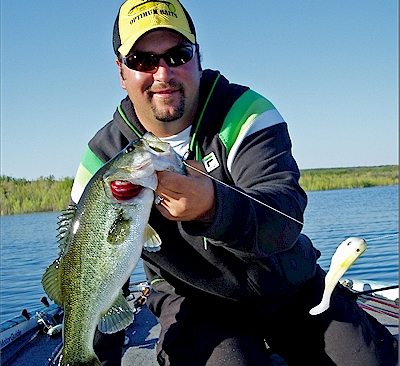
The nice thing about the Baby Line Thru when you hook a fish with it, the bait will slide up the line and not interfere with fighting a fish.
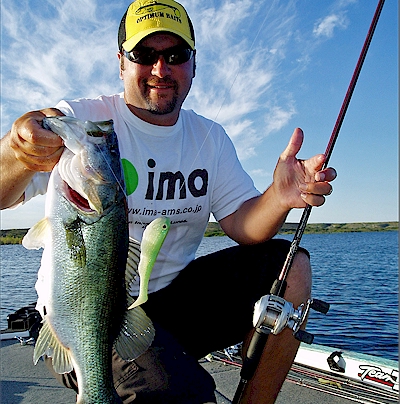
Since the BLT slides up the line, a fish is not biting down on it for the entire fight, so that helps you catch a few more fish than usual on one bait.
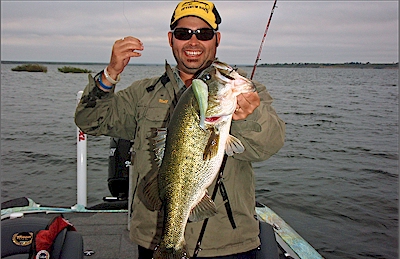
Yes! Baby Line Thru comes through in a big way for Matt!
| The Wind and the Rock N’ Vibe |
Also in the afternoons, or any time we were along a flooded treeline or a windy bank, we went with the ima Rock N’ Vibe lipless bait. Now that’s not a very big bait, but we went with that because a lot of the baitfish that we saw on Amistad this time were surprisingly tiny. So the Rock N’ Vibe’s a little loud, noisy bait that matched the hatch.
Actually, we did really well with the Rock N’ Vibe. Any creek we found that had just a little bit of stain or streaks of mudlines or wind blowing against brush lines or treelines where you could stay off a ways with the Rock N’ Vibe and cast into it – we caught numerous fish that way.
In many of these creeks, the water was high from recent flooding, so there’d be an outside treeline, and you’re not really near the flooded bank in these cases. So we were just staying ‘outside’. The trees were out in the flooded water, and you can see that in some of the photos.
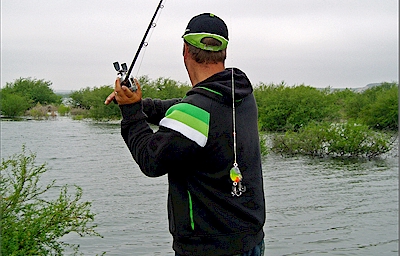
Fishing the treelines was outstanding with the lipless Rock ‘N’ Vibe.
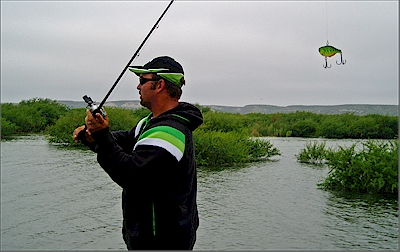
The backs of any creeks are places an angler can look for year-round action on Amistad. They’ll always be some shallow fish in the backs of the creeks. So you can go there anytime. With the Rock N’ Vibe in the wind, depending on the depth we were fishing, just cast out, and as soon as it hits the water start reeling. Give it a few jerks, kind of rip it back and forth. That bait, you can reel it slow and you can reel it fast, and it still is going to come in true without any trouble every time. So you can work it erratically.
What I particularly like when its windy (which it was this trip), is if there’s any kind of a mudline formed from the wind pushing against a bank, any bank.
Mudlines are awesome for throwing lipless crankbaits and it’s something I’ve always been successful at doing – fishing mudlines with a lipless bait.
Fish can get under a mudline, and even though it looks like its muddy, actually under the water, under a mudline, it is really clear under there. So basically, the mud is only a film over the surface, which is like perfect cover to a fish. Best of all, its a kind of overhead cover that you can fish right through it with treble hook lures! It’s pretty amazing that most of the mud is floating around on the surface. Yet underneath it is real clear.
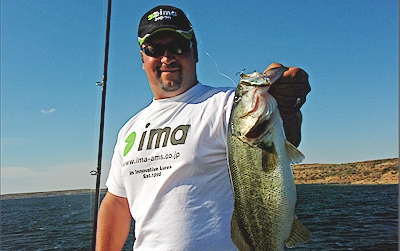
Some great fish were landed on this trip courtesy of the ima Rock N’ Vibe.
| Late Afternoon Happy Hour |
And then in the late afternoons and evening hours, that was when everything just got awesome. The fish would come up, start schooling and start busting on bait.
The nice thing about when they are busting like that, it seems you can catch them on just about anything you want at those moments – and indeed we did! We had all the rods ready on deck with the different ima baits. You can throw the Flit, the Skimmer, the Shaker, Rock N’ Vibe or Roumba, and pretty much catch fish on all those when they’re schooling and breaking on bait on the surface. It’s a good technique to rotate through the different ima lures at such times. After you catch one or two fish on one bait, switch up and throw another bait so you don’t give them too much of the same one. If you rotate lures, you can catch a couple more fish faster that way.
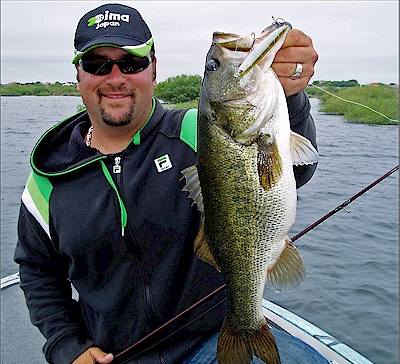
The ima Skimmer proved perfect for late afternoon and evening topwater schooling action.
| Rod, Reel and Line Recommendations |
We had most models of ima baits and BLT swimbaits rigged on separate rods for the duration of our trip. As discussed throughout, we found times of day when and locations where one or another bait seemed better-suited to the situation.
For a lake like Amistad with some pretty tough cover and equally tough fish, we fished everything on 15 pound test baitcasting tackle pretty much straight across the board.
The Roumba and the Skimmer topwaters, we fished them on P-Line CXX. That’s a copolymer line and it floats. You want those baits to be on a line that can help keep them on the surface, yet won’t take away from the action.
On the Flit suspending jerkbait, we liked it better on sinking fluorocarbon line.
The Rock n Vibe really didn’t matter much. We fished it both on P-Line CXX and on fluorocarbon.
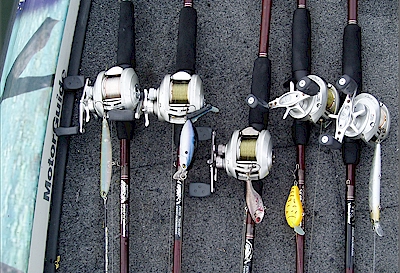
| Come on Down! |
When Matt and I were here, the lake was flooded, so fish were scattered into the newly-flooded water, but this is not as unusual as it sounds for lakes like Amistad. This far south and on other similar lakes in Mexico, they tend to have seasonal water level fluctuations, depending on the year.
During this trip, we had some consistently strong winds. But even with all that, we had a pretty good trip.
The water color on Amistad is usually pretty clear, and as the lake fluctuates up and down, there is always going to be some of the same kind of cover as we described in this article, brush, trees, grass, creeks and so on, either being flooded or exposed. Amistad is filled with grass, cover and brush, so the fishing areas just expand or contract as the water goes up or down, and the fish tend to adjust to that fairly well.
If you ever get a chance to go there when the lake is low, spend as much time as possible looking over the entire place – and learning it. I think I have a pretty good memory and can remember certain things, obviously not everything, but then when the water comes up, I remember things like there’s a great ledge that should be coming up here, and then you can find it on the graph, and usually something like that, where the old shoreline used to be, you can throw out and catch a good fish on it right away.
As the water level rises, you have to really think in your mind and get a handle on where was that old shoreline. Cause that old shoreline is what those bigger fish become accustomed to, and a lot of those bigger fish like to stay on it. They can be very territorial, and they like to kind of stay on some of those older shorelines, even when a good amount of new water has risen over them.
Now you know, many of the bigger fish are going to live deep there, that’s just their nature. So keep that in mind at Amistad.
If you go to Amistad, of course there won’t be the same conditions we faced, but you should hopefully still be able to try some of the ima lures and tactics described in this trip report. Everything we’ve described is a typical day starting with a couple of hours of topwater, and then the fish stop roaming or chasing, pull into the cover, and once the sun peaks overhead after noon, you can go deeper down off the grasslines, and then find the schools up top toward the end of the day. A guy can go down there most any day of the year, spring, summer, fall, and being it’s so far south, the climate stays warm, so there isn’t that much of a winter. You can pretty much follow the plan I’ve given you here and catch fish all year round.
The awesome ima baits and swimbaits we discussed, those were our best choices, and I’d say they’re my perennial choices for this lake. I’m pretty sure I’ll be packing more of the same great baits the next time I journey there.
If you go to Amistad, I hope you can pretty much follow this story and try some of the lures, tactics and types of spots we fished, as they should have a chance to work most anytime there.
Like Matt and I, you may catch a lot of fish and some good ones. We hope you have a great time.
| Where We Stayed |
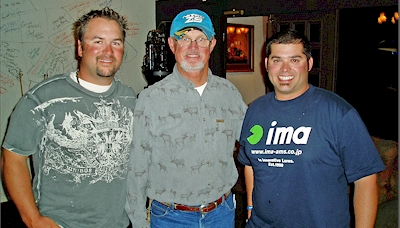
“We stayed at Byron Velvick’s Amistad Lake Resort. It just so happens Rick Clunn (center) was there teaching a class in bass fishing. So it was good to spend a little off season time hanging with a guy like that,” says Fred.
| Thank You! For Reading the ima Emailer |

ima’s a big name in Japan where ima is known for its hardbaits. ima is now making a big name for itself in North American too, with the help of U.S. bass pros who have designed new ima hardbaits for the USA.
ima EMAILER ~ October 2008
| Welcome! to the ima EMAILER ~ October 2008 Issue |

The IMA EMAILER brings you news from ima pros Michael Murphy, Fred Roumbanis, Bill Smith and ima pro staffers across the USA and worldwide.
| ima Pro Michael Murphy Connects the Dots for Fall Fishing |
As children, we probably all have played with connect-the-dots books. Each page starts as a puzzle, and by connecting the dots, a pattern appears. Fall fishing can be the same way, puzzling at first, but by connecting the different parts, successful patterns emerge.
| The Drawdown Connection |
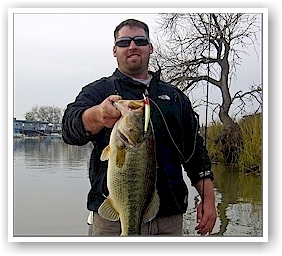 The first factor I’d like to discuss for the fall time of year is drawdown on drawdown lakes. Most common occurrences from my knowledge of drawdown lakes are from Missouri east to North Carolina, south to South Carolina, back across to Texas and about everything in between. In other words, the Midwest and Southeast, (with the exception of Florida). However, I presume a lake could be drawn down most anywhere there’s a way to do that and a reason.
The first factor I’d like to discuss for the fall time of year is drawdown on drawdown lakes. Most common occurrences from my knowledge of drawdown lakes are from Missouri east to North Carolina, south to South Carolina, back across to Texas and about everything in between. In other words, the Midwest and Southeast, (with the exception of Florida). However, I presume a lake could be drawn down most anywhere there’s a way to do that and a reason.
What causes the drawdowns, if you are not familiar with it, these lakes tend to be the result of damming so they’re actually reservoirs or man-made waters, not original natural lakes. The annual late season drawdowns on them are man-made too – and usually scheduled to take place after the summer recreational water use season is over – but while it is still decent weather for people who live around the lake to perform dock/ramp/retaining wall repair and so on. Also to lower the water level to prepare for spring rains to keep areas from flooding. In natural lakes, drawdowns are less common unless there is a dam of some sort that was put on a natural lake after the fact so that the water level can be controlled in much in the same way.
Why I’ve mentioned this is that drawdown lakes especially as you get toward Kentucky and farther south, you have a big crayfish move that coincides with when the drawdowns start.
| The Crayfish Connection |
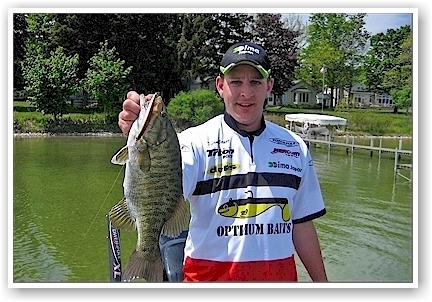 In drawdown lakes or most any typical lake, crayfish generally live in water that’s 10-12 feet deep or less. On most lakes, they’re going to be in that opportune depth range. In clearer lakes, they may exist deeper as well, down to 20-30 feet.
In drawdown lakes or most any typical lake, crayfish generally live in water that’s 10-12 feet deep or less. On most lakes, they’re going to be in that opportune depth range. In clearer lakes, they may exist deeper as well, down to 20-30 feet.
In anticipation of winter coming, crayfish start to move into areas where they can burrow, and usually that starts around the drawdown.
When I say crayfish move, it’s not up or down. It’s sideways. They’re moving from a harder bottom to a softer bottom. Typically, they’re not changing depths, although survival instinct may tell them to go a little bit deeper if the water level falls too quickly.
The kind of move they make can be from sand to clay, sand to silt, from rock to clay – from a hard bottom, including sand in the category of a hard bottom to a softer bottom where they can build a winter home that will last till spring without collapsing in on them.
In the south, it can be water temperatures around 70 degrees when crayfish start to move. The farther south you go, the more it’s going to be like around 70, maybe even 75 when the crayfish start to migrate from summer feeding to winter burrowing locations. Once you get so far south, it just doesn’t happen. The farther south you go, the less likely the crayfish are to burrow and go dormant, just like the largemouth. The more likely they are to stay out year round. For example in Florida, Lake Okeechobee, there are crayfish that probably don’t burrow at all just because it stays warm most of the year. As you get way south, that whole low metabolism/hibernation phase of winter gets skipped.
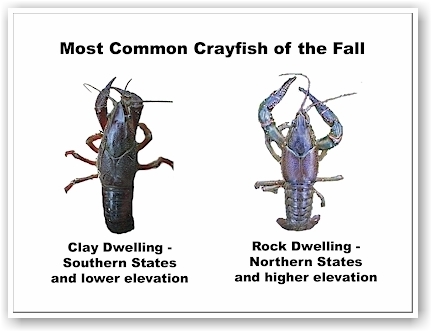 In the north, water temperatures around 65 to 60 trigger the crayfish movement. At the extreme north range, those crayfish being totally different species, probably don’t burrow at all because they’re more of a year-round rock-dwelling species. A lot of it is they’re just selective to the different environments. There’s just not a lot of clay for them to burrow on rocky lakes up north. The farther north you go, the less softer bottoms there are, and the more rock there is in general. So there are more rock-dwelling species of crayfish that stay out year-round. They don’t have a lot of clay to burrow in like the other clay-dwelling species.
In the north, water temperatures around 65 to 60 trigger the crayfish movement. At the extreme north range, those crayfish being totally different species, probably don’t burrow at all because they’re more of a year-round rock-dwelling species. A lot of it is they’re just selective to the different environments. There’s just not a lot of clay for them to burrow on rocky lakes up north. The farther north you go, the less softer bottoms there are, and the more rock there is in general. So there are more rock-dwelling species of crayfish that stay out year-round. They don’t have a lot of clay to burrow in like the other clay-dwelling species.
Where we see the most variety of clay-dwelling crayfish is in the middle belt where you have an overlapping ranges of different clay-burrowing species – Missouri, northern Alabama, Mississippi, Georgia, SC, NC, that whole belt right through there we see a lot more diversity of crayfish species. The clay-dwellers are usually like a reddish or a black/red shad color or a brown/orange pumpkin because they are clay-dwelling and burrowing species, but up north, those color crayfish are less likely to be common. Green pumpkin or dark browns are more common crayfish color up north. Up north the gold shiners and alewives are present. Down south, gizzard shad. That’s how the forage changes just going north and south.
It’s more than just temperature that triggers the crayfish move, but a combination of the tilt of the earth toward the sun and the length of day, as the days get shorter. The most obvious indicator or gauge we have of the days’ shortening is water temperature because as the day gets shorter, there is less UV and less sun hitting the lake heating the water, so it doesn’t stay heated up as long as in summer. It doesn’t have that retained higher temperature. So the dropping of water temperature is a reflection of the shortening of the day. Factor that with a lake that may have draw down, these are all indicators to crayfish that the time of winter is coming closer and that’s when they’ll be triggered to move. Again, it could be closer to 60 degrees up north when the crayfish start to trigger to move, around 65 degrees through the middle of the country, and say 70 at the southern end.
Across the entire country, we’re mostly talking of a falling water temperature from 70 to 60, give or take a few degrees, that triggers the crayfish move.
| The Lake Location Connection |
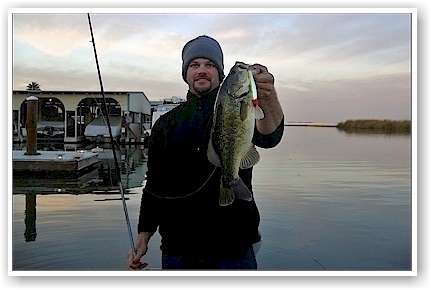 A lot of your lakes that have drawdown, they do not have a whole lot of aquatic vegetation rimming the shoreline just because of the fluctuating water level. Any grass that gets seeded each summer, gets dried up during the ensuing drawdown. What happens is the harder bottom areas, especially in drawdown lakes, weedy stuff that was able to provide habitat during the summer, the aquatic plants that got rooted to rocks or to hard bottom becomes the preferred crayfish habitat for a few months – until late fall (coinciding with drawdown) which gets the crayfish population migrating into nearby burrowing areas of softer bottom.
A lot of your lakes that have drawdown, they do not have a whole lot of aquatic vegetation rimming the shoreline just because of the fluctuating water level. Any grass that gets seeded each summer, gets dried up during the ensuing drawdown. What happens is the harder bottom areas, especially in drawdown lakes, weedy stuff that was able to provide habitat during the summer, the aquatic plants that got rooted to rocks or to hard bottom becomes the preferred crayfish habitat for a few months – until late fall (coinciding with drawdown) which gets the crayfish population migrating into nearby burrowing areas of softer bottom.
So our main locus for finding fishing hot spots is to focus on bottom substrate composition in lieu of vegetation on drawdown lakes.
The thing about drawdown too, what makes it so good is as the shoreline recedes, you can more clearly see the substrate which would normally be underwater or hidden by shoreline vegetation.
What we are looking for are the transition zones from hard to soft substrate and especially the areas where hard and soft substrate mix or overlap.
The transition zones in a lot of cases are along the sides of points. Points are typically extensions of shallowing portions of channel swings or some sort of shoreline edge connection to the main lake. There’s often some sort of transitional substrate zone going down the sides of points – those are usually areas that have the rock to clay transition. The harder, outer tips of the points gradually transition down the sides, and give way to the softer, sediment-filled back pockets. Some points do, some points don’t.
The typical rule of thumb is that the slope of the bank above the water is typically the slope of the bank below the water. So if you see a flatter bank transitioning to a steeper bank, those areas are always good to look at. Those sharp slopes could signal underwater channel bends or swings, but a lot of guys miss them since much of the transition zone is underwater and can’t be seen except on electronics. Where you want to be is in the transition zone, that ten to fifteen yards into each stretch of hard and soft and including the mixture in between. That’s going to be where a lot of fish are setting up in that area. The fish can detect the craws there, and those bottom transition areas are what the fish are going to be interested in. If you are good at reading your graph, you’ll see a double echo or a thinner bottom line (a harder ping) over the hard bottom, and a thicker bottom line (or softer ping) on softer bottoms. If at all possible, you can use any clues from what appears on the shoreline as a visual guide to get you into the transition zone, along with your electronics.
The most obvious places with sharp slope changes are of course, emergent points. This time of year I like the shorter points, the ones that are not as long and tapered. The steeper-looking points can be best and in some cases, even rounded points. Those are usually the areas that the fish are going to winter up on. They’ll get onto the long, gradually-tapered points, but it seems more in the spring and summer months. Right now, during the drawdown and crayfish move, focus on finding the substrate transition zones down the sides of the points, and focus more on your shorter points. This time of year, the bass are naturally attracted to such areas because that’s where the crayfish move is happening.
| The ima Skimmer Topwater Connection |
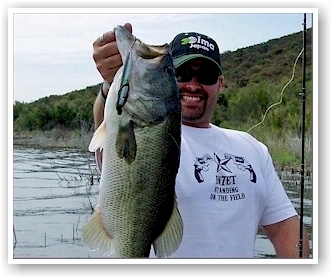 You’ll know you are in the right areas around this time of year, you may find bass with their noses scuffed up from rooting in the rocks for craws. Also when fish are feeding heavily on crayfish, you can feel their stomachs and the hard edges of the crushed-up crayfish can feel like gravel in their stomachs. Those are good areas where you want to be.
You’ll know you are in the right areas around this time of year, you may find bass with their noses scuffed up from rooting in the rocks for craws. Also when fish are feeding heavily on crayfish, you can feel their stomachs and the hard edges of the crushed-up crayfish can feel like gravel in their stomachs. Those are good areas where you want to be.
A lot of guys are going to try to match the hatch with crayfish jigs or soft craw baits and so on.
Matching the hatch is great to do especially in a tournament or on a day when the fishing is slow or the fishing is tough, then matching the hatch is good to do. When things slow down on tougher days, you may need to fish slow-moving bottom contact baits.
But this time of year, most days you don’t have to do that because fish are typically concentrated, the competition is high, and they are very, very aggressive.
So despite the prevalence of crayfish which serves to aggregate bass in these areas, the real thing you’ve got to remember is a lot of fishing is just:
- covering water,
- keeping the bait in the strike zones to which fish will commit (surface, mid-depth and/or bottom) and
- throwing baits that don’t necessarily match any hatch but are nevertheless effective both in their action and have the right sound for a given area.
And that’s where the ima Skimmer (surface strike zone) and the ima Flit jerkbait (mid-depth strike zone) I think are very, very successful.
Keep in mind too that there are many baitfish running down the sides of points into the small run-off areas and sedimented, sun-warmed pockets that often exist at the shallow ends.
Use a run and gun technique. Look for those specific areas and look for the sides of the points where deep water butts up right next to it. Tune in to those transitions and just go after it. You could hit eight or nine of these areas with nothing and in the next one, load the boat.
You can cover water much more quickly this time of year by using things like the ima Skimmer topwater stickbait especially when that surface water is still warmer than 65 degrees. If it’s a little windier, the ima Roumba grabs more of the surface and throws a more visible wake on windier days. But most days, the Skimmer’s what I use this time of year when the water remains warm enough for bass to commit to a surface strike.
A lot of people put the Skimmer in the category of other walking baits. I think the Skimmer is much different. It’s kind of in its own category. It looks like other walking baits, but it doesn’t push water, it cuts through the water. To see the design of this bait, the body cross-section is a teardrop shape. And in fact the water will flow over its back and will create a swirl right behind it every time you jerk it, which a lot of baits won’t do that. Other walking baits will push water and splash but the Skimmer is one that actually creates a swirl behind it. If you look at the Skimmer on videos or when you are first working it, you’ll mistakenly think that fish are swirling at it – and that’s what it does, it creates the idea, the impression that there’s a fish trying to eat it. So a fish is more likely to become competitive when it thinks another fish is there (but really is not there). So it will see the surface swirl – and try to get the Skimmer before another fish gets it. That’s the beauty of this bait – that boil, that swirl behind the Skimmer.
If you’d like to see the Skimmer in action, there are ten short video clips that show the Skimmer’s action at
Also, people have got to remember that the preferred temperature range of the largemouth bass metabolism is roughly 72 degrees. With a 72 degree surface temperature, 20 feet down might be 60 degrees. So fish are obviously going to be active on the surface and chase for bait when the surface layer of water isn’t far from 72 degrees. And that’s when topwaters like the ima Skimmer are really effective – when the surface water temperature is anywhere above 65 degrees or so.
| The Baitfish Connection |
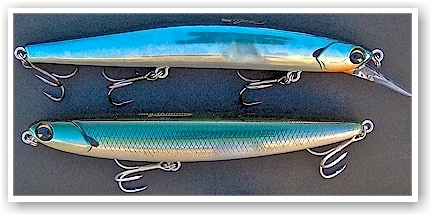 The late fall season is Mother Nature’s way of giving one last opportunity for bass to get a lot of fat in them, necessary to produce their eggs over winter. The high protein of the crayfish is only one part of the banquet. The other part is the high protein of the prevalent baitfish that are migrating down the sides of these very same points making their way to the backs. The deal is a concentration of everything on the sides of these short points or transition zones from deep hard bottom to shallow soft bottom. You’re having areas that are just packed full of options for the bass. There are baitfish moving, crayfish moving. It’s just a cornucopia of plenty for bass before going into winter hibernation. Just before their metabolism decreases, they are putting on weight for next year’s spawn. They’re having one last good feed right now before winter and then they’ve got one good feed as things warm up in the spring to recharge strength before the spawn.
The late fall season is Mother Nature’s way of giving one last opportunity for bass to get a lot of fat in them, necessary to produce their eggs over winter. The high protein of the crayfish is only one part of the banquet. The other part is the high protein of the prevalent baitfish that are migrating down the sides of these very same points making their way to the backs. The deal is a concentration of everything on the sides of these short points or transition zones from deep hard bottom to shallow soft bottom. You’re having areas that are just packed full of options for the bass. There are baitfish moving, crayfish moving. It’s just a cornucopia of plenty for bass before going into winter hibernation. Just before their metabolism decreases, they are putting on weight for next year’s spawn. They’re having one last good feed right now before winter and then they’ve got one good feed as things warm up in the spring to recharge strength before the spawn.
When we get closer to 60 degrees in most areas, except way north where it’s probably more like the 60 to 55 range, once you get close to that temperature, that’s an indicator in my book that the crayfish for the most part, a lot of the crayfish are done burrowing.
As you get closer to the 60 degree range in the middle and south of the country, from Missouri east to North Carolina, south to South Carolina, back across to Texas and about everything in between, a lot of those crayfish will be burrowed as you get closer to 60. So the bass will tend to shift more toward the baitfish bite, and those baitfish will tend to suspend in the deeper water, especially as the water gets colder, and this is all relative to water color of course.
As the surface temperature. tapers down to 60, now those fish are forced to not go to where their preferred temperature is or where they feel most comfortable but where the food is. The crayfish are burrowed or no longer a forage option at this water temperature. So the forage base at this point shifts to suspended baitfish in relatively deeper water.
| The ima Flit Jerkbait Connection |
If they’re no longer eating the Skimmer topwater, as the water gets closer to 60, they’re going to start turning on the deeper-running Ima Flit jerkbait.
With a 60 degree surface temperature, it could be 50 to 55 degrees around 15-20 feet deep so the bass at that point are already getting into the lethargic winter stage. They’ve got to slow down, are less likely to commit to the surface because not only are they more lethargic, but they are also sitting in deeper water. So you’ve got to get down more to them. You’ve got to get down to that 6-8 foot range and meet them halfway with something that’s closer to the strike zone – and that’s where the Flit comes into play.
| The Rod, Reel and Retrieve Connection |
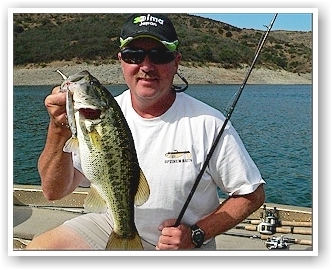 A guy could get away with the same type rod for both the ima Skimmer topwater surface walking bait and the ima Flit jerkbait. And the way to work both is with the same walking motion. Keep the rod tip below waist high and just work the rod with the short twitching downward motion to where you can get both the Skimmer and Flit to have side-to-side darting actions on every downward rod stroke – known as ‘walking the dog.’ The only difference is, of course, the Skimmer dances on the surface whereas the Flit dives 6-8 feet, and as the water gets colder, add more pauses to your retrieve with the Flit jerkbait.
A guy could get away with the same type rod for both the ima Skimmer topwater surface walking bait and the ima Flit jerkbait. And the way to work both is with the same walking motion. Keep the rod tip below waist high and just work the rod with the short twitching downward motion to where you can get both the Skimmer and Flit to have side-to-side darting actions on every downward rod stroke – known as ‘walking the dog.’ The only difference is, of course, the Skimmer dances on the surface whereas the Flit dives 6-8 feet, and as the water gets colder, add more pauses to your retrieve with the Flit jerkbait.
My rule of thumb for selecting a topwater/jerkbait rod for a bass boater is that I typically recommend a rod that can point straight down when you’re up on the bow of the boat, to where the rod tip does not slash the water on the downstroke. Now, the ideal rod length is relative to your height. One must remember I am 6’5″ so what is comfortable for me may not be comfortable for a guy who’s 6′ tall or 5′ 6″.
The Fenwick Elite Series Pitchin’ Stick I most often use only comes in one length, 6’9″. The model number is ECPS69MH-F. I like this rod for jerkbaits and topwaters. Another one I also like is the Fenwick Techna AV 7’0″ MH, Model AVC70MHF. It is extremely light and sensitive with a good tip action.
As I say, I like where the rod tip is still out of the water on the downstroke. So for a guy who’s 5’6″ or shorter, you may want a 6′ rod. Anglers approximately 6 feet tall may want a 6-1/2″ foot long rod. You want it just short enough to where you are not slashing your rod tip into the water every time you work the bait. As I say, you work both the Skimmer and Flit nearly the same – with a walking motion. Whether it be on the surface or 6-8 feet down, it is the same rod motion, the same twitch motion and what I’m comfortable with using is a 6.3:1 gear ratio reel, which is the most common gear ratio for baitcasters. The only difference is I use 12 lb mono for the Skimmer topwater which floats. When you go to fluorocarbon, it will sink and it will disrupt the action of the Skimmer. With the Flit jerkbait, yes, you can get away with 12 lb mono too – but I am a bigger fan of 10 lb test fluorocarbon which sinks. So when I go to a jerkbait, I lean more toward fluorocarbon just because of the sinking factor that helps me to obtain that deeper range, thereby getting down there a little closer to the fish.
So I prefer the same rod action for both the Skimmer and Flit, rod length matched to your height, and a 6.3:1 gear ratio. I’m using an Abu-Garcia Revo personally, and in my case I use the Fenwick Elite and Techna AV series rod. But most important point for you here is you’ll be much better off to just match the rod length you use to your height. The objective being that the tip won’t hit the water surface on the downstroke.
For the guys who are fishing off the bank (and there are many, many more of them than fish off of boats), whenever you are fishing from the bank always go for the longer rod. That’s why we see surf fishing rods along the coast that are 8-9 feet long. That’s why fly rods are typically 7-8 feet. The same thing applies to bass fishing from the bank. Use the longest rod you can get away with. For bass fishing, that mostly means a 7 footer. If you can use a 7′ rod without casting into trees, I say go for it, regardless of your height. If there’s a lot of overhanging shoreline cover, you may have to go to a shorted rod – but go with the longest rod you can get away with, in order to make longer casts. On the bank, there’s a lot of noise – footsteps on the bank, snapping a stick you step on, that can be picked up by fish and is associated with predation – bass are more wary of noises coming down the bank because that’s where many predators come down to the waterline. So bass are more naturally wary of noises coming from the bank rather than noise coming from a boat. Working a Skimmer or Flit from shore, keep you rod tip down near the water level, kind of down on an angle instead of straight down.
Well, we’ve made a lot of different connections today to try to make the puzzle of late fall fishing patterns seem clearer. Thank you for reading along. I hope you get out there this weekend and connect on your own with the ima Skimmer and Ima Flit.
– Michael
| Thank You! For Reading the ima EMAILER |

ima’s a big name in Japan where ima is known for its hardbaits. ima is now making a big name for itself in North American too, with the help of U.S. bass pros who have designed new ima hardbaits for the USA. Find these great ima Baits at BassTackleDepot.com
Summer Bass Fishing Tips

1. Go Dark If your water is a popular recreation destination consider fishing after dark. Things usually settle down at this time and the fish typically become more active. Safety is the big concern after dark. Don’t fish alone; know your water; always wear a PFD; make sure your boat is properly lighted; and watch for other boat traffic.
2. If you can’t fish after dark go early Most fish are more active at dawn than in the evening during the hottest days of summer. It’s easy enough to get up around 4:00 a.m., fish a few hours, and then go home and take a nap.
3. Deep-diving crankbaits are hot Deep-diving crankbaits are super bass lures during July, August and into September. Throw them over offshore breaks and ledges. Long cast and very fast retrieves are usually your best option.
4. Fish schooling bass Often bass will surface-school during the hottest days of summer. Look for them breaking the surface and cast directly into the school. Small topwater baits, spoons, in-line spinners and crankbaits are effective lure choices for this type of fishing.
5. Release your bass immediately Survival times for bass in hot weather, hot water conditions are short. Release you fish immediately so you can catch them another day.

“Often times bass will hide under very heavy weed mats that make catching them almost impossible,” says the 2006 Toyota Tundra Bassmaster Angler of the Year. “But, I said almost impossible, not impossible. It’s a lot of hard work to get to them but when you do it’s often times the mother lode of bass holes. “
One way to get through the heavy mats and into the mother lode is to punch a plastic bait through the mat and allow it to drop into the underlying shade. Here are a few tips to help you do this.
1. Use a heavy weight Iaconelli typically uses a Tru-Tungsten bullet weight up to 1 1/2 ounce. Of course, a big, heavy jig with a plastic trailer is also an option.
2. Use heavy line Braid up to 85-pound-test is a common and effective choice.
3. Use a serious flipping stick Flipping rods – the heaviest you can find work best. It’s not easy to drag a 5 pound largemouth with 10 pounds of grass to the boat.
4. Learn to cast vertically Practice casting with an eye towards throwing your weight as high as possible and allowing it to drop straight down into the mat. Some anglers, including Iaconelli, can throw their rigs 30 feet or more into the air. The resulting force will punch through surprisingly thick mats.











